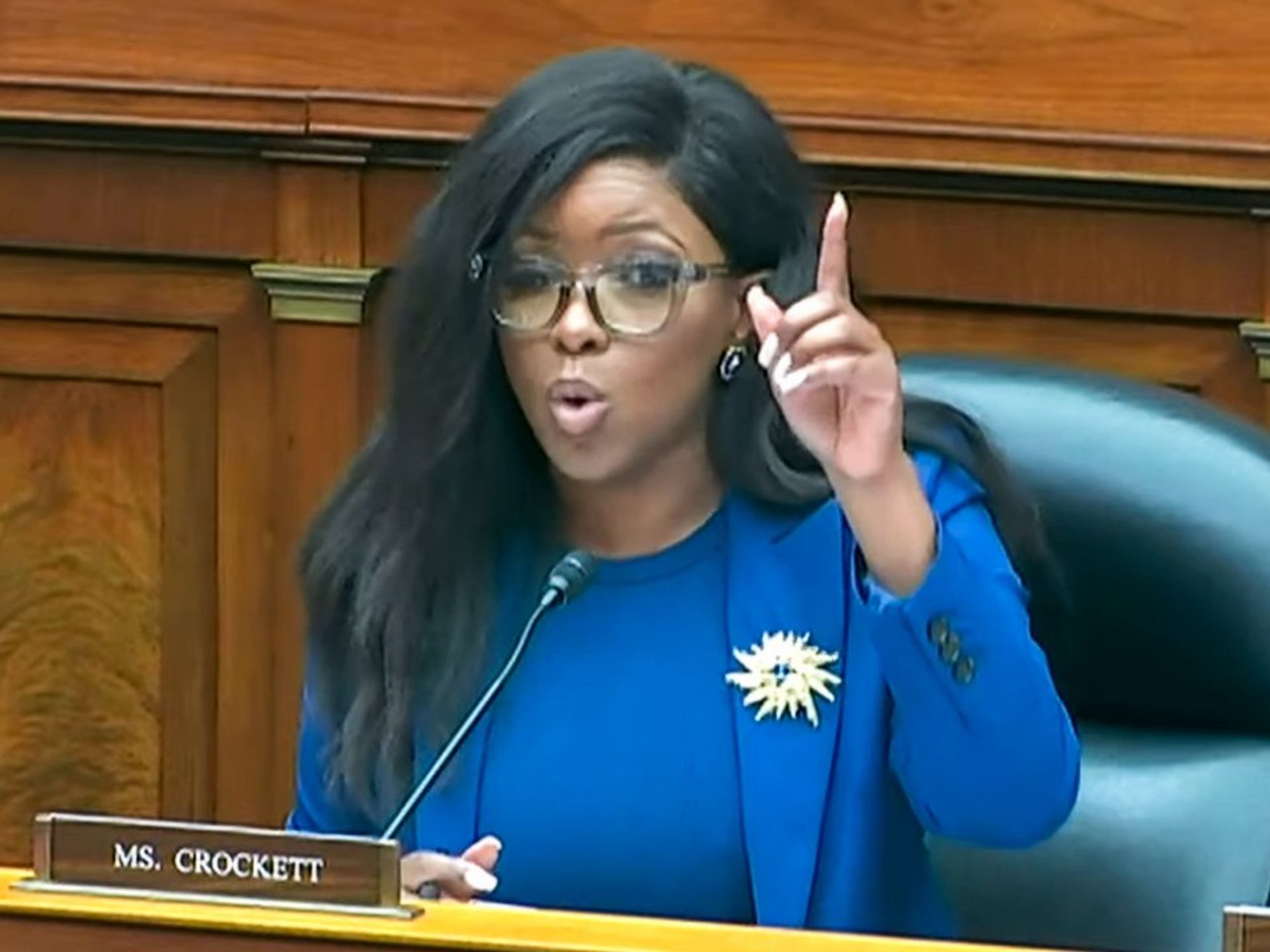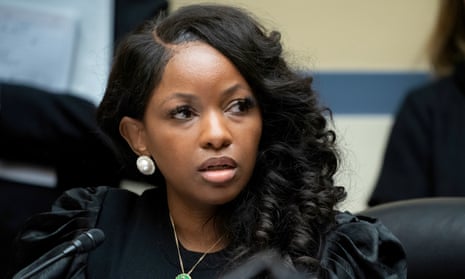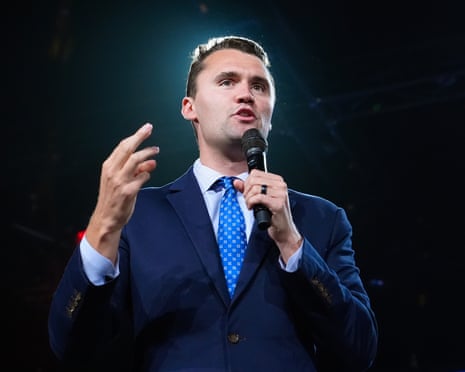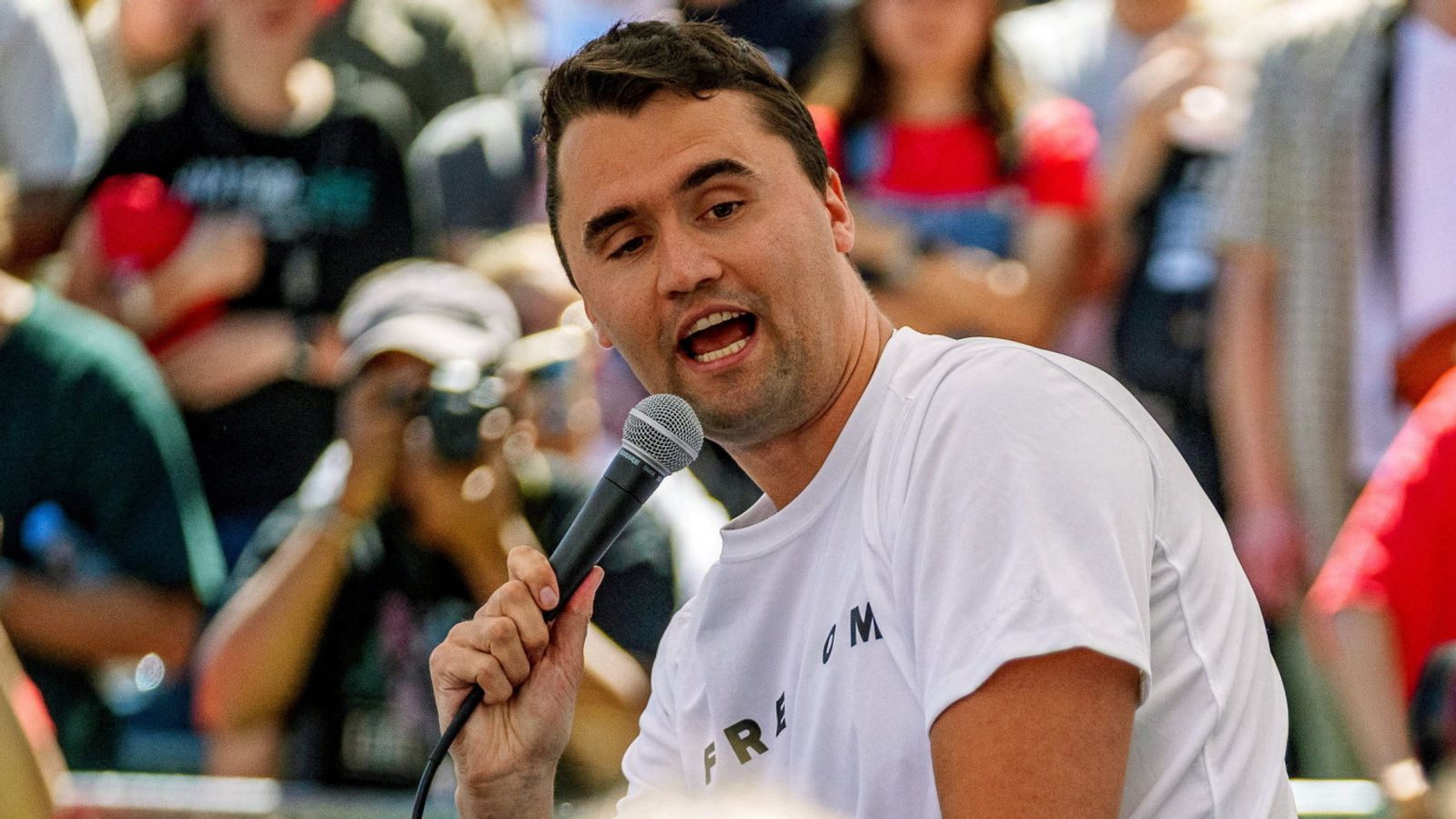“That was never a normal incident,” Jasmine Crockett insisted — claiming that Charlie Kirk had uncovered something that could shake the entire system, and now Turning Point USA is facing an unprecedented crisis.
It began with a whisper. A name passed quietly through the halls of power and influence: Charlie Kirk. Few outside the inner circles of Turning Point USA could fully grasp the gravity of what had unfolded, yet those within the organization sensed immediately that nothing would ever be the same. Jasmine Crockett’s words, when they finally emerged, cut through the hum of speculation like a sharp blade:
The phrase would be repeated, dissected, and debated across social media and political forums. But what did it really mean? For those paying close attention, it suggested that Kirk had stumbled upon something monumental—something that had the potential to destabilize the very foundation of the organization he had helped build. In the hours following Crockett’s statement, the quiet corridors of Turning Point USA transformed into spaces of tension, uncertainty, and fear.
It was a night that would leave insiders questioning their roles, alliances, and, above all, their assumptions about the organization’s inner workings.
Turning Point USA had long been known for its rapid rise, its ability to command attention in the corridors of youth politics, and its uncanny knack for shaping narratives.

But beneath the polished public image, sources suggest, there were layers of complexity and secrecy few could penetrate. Among these was the so-called “silent agreement”—an internal understanding whispered about but rarely documented.
According to sources who asked to remain anonymous, Kirk’s discovery was tied to this hidden framework. It was a set of arrangements and understandings that controlled the organization’s financial decisions, its donor interactions, and even, to some degree, its public messaging. The details were murky, obscured intentionally through layers of internal memos, selective disclosures, and private conversations.
What made Kirk’s position unique was not merely his awareness of these arrangements, but the sheer audacity with which he had confronted them. Some insiders claim he had begun asking questions no one else dared, quietly challenging assumptions that had remained untested for years. The result was a tension that simmered under the surface, invisible to the casual observer but palpable to those who walked the halls daily.
For Jasmine Crockett, the experience was deeply personal. A seasoned figure in political circles, Crockett had spent years navigating the intricate dance of loyalty, power, and ethics. But nothing had prepared her for the storm that followed Kirk’s revelation.
She recalls the moment she first became aware of the circulating internal notes. “It wasn’t just the content,” she says. “It was the realization that people were keeping secrets on a scale I hadn’t anticipated. That someone of Charlie’s integrity had stumbled onto it—it was… alarming.”
Crockett’s perspective offers a rare glimpse into the emotional undercurrent of the organization. While external observers saw public statements and press releases, those within experienced a far more intricate reality: colleagues caught between personal loyalty and professional obligation, emails and memos that hinted at larger truths without ever fully revealing them, and a collective anxiety that grew with each passing day.
In this environment, even small actions carried outsized significance. A forwarded email, a hastily deleted note, a cryptic remark in a meeting—each became a potential spark capable of igniting larger reactions.
Then came the message. Not a formal announcement, not an official memo, but a single, enigmatic note that made its way through private channels and leaked, eventually, to a wider audience. Its tone was measured yet ominous; its contents, though vague, suggested that the events surrounding Kirk’s discovery were far from over.
The circulation of this note sent shockwaves. Staff members began whispering in corners, social media analysts speculated feverishly, and donors watched with increasing concern.
The message served as a reminder that within organizations like Turning Point USA, information—both what was shared and what was withheld—held immense power.
Observers outside the organization struggled to parse fact from conjecture. Every interpretation seemed possible. Every potential explanation, no matter how improbable, was given weight because the organization’s internal transparency had, in many ways, evaporated under the weight of secrecy.
For Crockett, the experience carried a profound philosophical weight. “Knowing too much,” she reflects, “is both a gift and a curse. It illuminates, but it also isolates. It forces choices that you wish you didn’t have to make.”
Her reflections underscore a tension at the heart of the situation: the interplay between knowledge and responsibility. The questions Kirk had raised, the insights he had uncovered, and the dilemmas they produced were not merely procedural—they were existential.
Those who witnessed the unfolding events describe an atmosphere heavy with contemplation. Staffers debated ethics and strategy in hushed tones; leadership weighed reputational risk against moral obligation; donors considered the potential consequences of their continued involvement. Every decision, every conversation, was filtered through the lens of the organization’s newfound fragility.
As weeks passed, the initial shock evolved into a sustained period of upheaval. Internal reorganization, unexpected departures, and subtle shifts in messaging hinted at an organization attempting to recalibrate itself in response to newfound scrutiny.
Yet, despite these movements, there remained a pervasive sense that the story was far from complete. For many, the circulating notes, the whispered agreements, and Crockett’s public statements were simply the beginning.
They suggested that Turning Point USA had entered a new phase—one in which transparency, loyalty, and accountability would be tested in unprecedented ways.

The climax, for insiders and observers alike, was less a single event than a collective realization: the structures that once seemed immutable were, in fact, vulnerable. And at the heart of this vulnerability was the human element—the choices of individuals, the courage to question, and the consequences of those questions.
By the time the media and social commentators began to weigh in, the narrative had already grown beyond the confines of the organization itself. Analysts debated implications for youth politics, for public trust, and for the broader ecosystem in which Turning Point USA operated. The organization’s internal turmoil became a lens through which wider questions about power, influence, and ethics were examined.
For Crockett, the experience reinforced a fundamental truth: the interplay of secrecy and revelation shapes not just organizations, but the lives of those within them. And while the immediate consequences of Kirk’s discovery were being managed, the longer-term impact—on careers, reputations, and public perception—was still unfolding.
The story of Turning Point USA, as it relates to Charlie Kirk and Jasmine Crockett’s revelations, is far from closed. While public attention ebbs and flows, insiders understand that the organization has been irrevocably altered.
Crockett’s assertion that “that was never a normal incident” resonates because it captures both the extraordinary nature of the discovery and the extraordinary human stakes involved.
It is a reminder that, within organizations of power, every choice has consequences, every secret carries weight, and every revelation has the potential to change everything.
And as the wider world continues to watch, one truth becomes increasingly clear: this is only the beginning. The ripple effects of what was uncovered will be felt for years to come, shaping not only the internal dynamics of Turning Point USA but also the broader conversation about transparency, ethics, and influence in contemporary politics.
In the days following the circulation of internal notes and Crockett’s public statements, a peculiar tension settled over Turning Point USA. From the outside, the organization appeared outwardly normal: scheduled meetings went ahead, public statements were released, and events proceeded on time. Yet insiders knew the calm was deceptive. It was the quiet that comes not from resolution but from the weight of unspoken truths.
Employees spoke in measured tones, avoiding any mention of specifics, yet the air was thick with speculation. Small gestures—a paused conversation, a lingering glance, a carefully worded email—were interpreted as signals, as clues to the ongoing internal negotiations. The silent agreement, previously an abstract notion, had become something palpably alive, influencing every decision, every movement, every meeting.
For some, this period of quiet was almost unbearable. It forced reflection and, in many cases, confrontation with uncomfortable truths about loyalty, power, and ethics.
“You realize,” one staff member said under anonymity, “that the organization is bigger than any one person—but also that each person carries the potential to tip the balance.”
The ripple effects of Kirk’s discovery were subtle yet profound. While no immediate scandal erupted in public forums, the internal environment was irreversibly altered. Senior staff began reassessing their own positions: who to trust, which alliances were solid, and what information to withhold or share. Decisions that once seemed simple now carried layers of potential repercussions.
Donors, too, became a source of quiet tension. While public-facing communications emphasized continuity and stability, private channels revealed growing uncertainty.
Some questioned whether the organization could maintain its trajectory; others pondered the implications of being associated with an entity navigating an ethical and strategic minefield.
Meanwhile, the wider political ecosystem had begun to take notice. Analysts, bloggers, and journalists pieced together fragments of the story from public hints, social media reactions, and informal sources.
The narrative emerging in these forums was one of intrigue and tension—a story of secrecy, discovery, and the delicate balance between influence and accountability.
Amid these shifting currents, the personal dimension of the crisis became more visible. Jasmine Crockett’s reflections illustrate a complex reality: awareness of internal machinations is not merely intellectual—it is deeply human. The knowledge she carried imposed responsibilities, dilemmas, and emotional weight.
She describes moments of profound isolation: sitting in a quiet office, reviewing an email or note that revealed yet another layer of complexity, and realizing that any action she took—or failed to take—could have significant consequences. The tension between professional duty, personal ethics, and the instinct for self-preservation was constant.

It was this human element, perhaps more than any policy, statement, or internal memo, that defined the unfolding drama. Each individual’s choices, small and large, contributed to the organizational outcome. The silent agreement, while ostensibly structural, was animated by the decisions, fears, and convictions of those who operated within it.
One of the most striking features of the crisis was the way communication itself became a strategic tool. Every word spoken in private meetings, every forwarded message, and every public statement was analyzed for hidden meaning. Misinterpretation could spark panic; miscommunication could exacerbate tensions.
Some insiders began using indirect methods to signal concerns: nuanced phrasing in emails, subtle references in documents, and carefully measured tone in conversations. It became clear that understanding the subtext of communication was as important as understanding the content.
Social media amplified this dynamic. Even a minor hint from an insider could spark speculation that traveled faster than the organization could respond. While the notes and messages circulating internally were never intended for public consumption, once they leaked, they took on a life of their own—feeding discussions, debates, and theories that ranged from plausible to fantastical.
Crockett often returned to a question that transcended the immediate organizational concerns: what is the nature of power, and how should it be wielded? Kirk’s discovery, and the subsequent fallout, illuminated how fragile influence can be when built on secrecy and unexamined assumptions.
Through her reflections, it becomes clear that knowledge itself carries ethical weight. To know too much is to face choices that are uncomfortable, risky, and consequential.
The silent agreement, while a framework of operations, also became a symbol of moral and strategic dilemmas: the tension between transparency and discretion, loyalty and truth, stability and change.
This philosophical perspective resonated with many within the organization. It encouraged conversations about leadership, accountability, and the responsibility of those in positions of influence. The crisis, in other words, became not only a practical challenge but also a moment for introspection about the broader purpose and principles of the organization.
As weeks turned into months, the immediate heat of the crisis began to subside, but the uncertainty did not. The organization had endured a test it could not have anticipated. While structural adaptations were made and some internal issues were addressed, the fundamental lesson remained: systems, no matter how robust, are shaped—and sometimes undone—by the humans who operate within them.
Crockett’s reflections capture this perfectly. She notes that while external observers may perceive stability, insiders carry an intimate awareness of fragility, contingency, and consequence. The crisis was a reminder that influence and authority are never static; they are continuously negotiated, contested, and reaffirmed.
Candace Owens Reveals What Charlie Kirk Wrote About His Wife. These revelations open a web of mysteries involving internal collapse, chilling warnings, and a $2 million donor who suddenly “disappeared.ABC

Candace Owens Reveals What Charlie Kirk Wrote About His Wife: A Web of Secrets, Power, and Suspense
In recent weeks, a series of revelations by Candace Owens has captured public attention and sparked a whirlwind of speculation about Charlie Kirk, the conservative activist, and his wife, Erika Kirk.
What started as seemingly private messages has now opened a door to a much larger, more complex narrative—one that involves internal tensions, sudden financial withdrawals, and questions about loyalty, power, and strategy.
This is a story that blurs the lines between personal relationships and professional networks, raising crucial questions: is it mere coincidence, or is there a more calculated plan at work?
The Initial Revelations
Candace Owens, known for her outspoken nature and deep involvement in American conservative circles, recently shared a set of communications allegedly written by Charlie Kirk concerning his wife, Erika.
While the exact contents remain private, Owens described them as illuminating and, in some cases, alarming. According to her accounts, these messages suggested not only personal concerns but also hints of strategic considerations regarding the internal dynamics of Kirk’s organization and associated donors.
The public reaction was immediate. Observers were quick to note the tension between what had once been assumed to be private marital matters and the implications for a broader network of associates and supporters.
In particular, the sudden withdrawal of a $2 million donor from the organization fueled speculation. How often does a significant contributor back away without warning? Was this a reflection of internal disagreements, or something far more deliberate?
Erika Kirk: The Pivotal Figure
Central to this unfolding drama is Erika Kirk herself. Candace Owens highlighted her as a key figure whose responses could significantly alter the internal power balance. Erika’s role seems to extend beyond the private sphere; she appears to have influence over both the organizational culture and the perceptions of key supporters.
Experts in organizational dynamics note that the presence of such a figure often signals a tipping point. In organizations that rely heavily on public image, donor confidence, and internal cohesion, even small personal matters can ripple outward, creating unpredictable consequences. Erika’s decisions and reactions, whether public or private, are now under scrutiny, and many are watching closely to see how she will navigate this complex landscape.
Internal Collapse and Tensions
One of the most striking aspects of Owens’ revelations is the suggestion of internal instability. Descriptions of “internal collapse” and “chilling warnings” point to more than mere disagreements; they suggest a series of misalignments, possibly escalating to the point of jeopardizing organizational stability.
Internal conflicts in high-profile organizations are not uncommon, but when they intersect with personal relationships, the stakes are elevated. Owens’ statements indicate that Charlie Kirk’s communications may have inadvertently—or intentionally—highlighted fault lines that previously remained hidden. These messages, according to Owens, reveal concerns about loyalty, strategy, and the management of sensitive information, suggesting a precarious equilibrium within the organization.
The Disappearing Donor
The sudden withdrawal of a $2 million donor has only intensified speculation. In public reporting, donors of this scale are usually considered pillars of organizational stability. The fact that this individual “disappeared” without explanation raises questions about timing, motive, and the underlying dynamics within the organization.
While no concrete evidence points to wrongdoing, the optics are compelling. A sudden financial exit of this magnitude can destabilize operations, shift priorities, and trigger a cascade of decision-making challenges. Owens’ commentary implies that this event is not isolated but part of a broader narrative that involves strategic miscalculations, personal considerations, and the delicate balance of influence.
Private Messages, Public Consequences
Perhaps the most compelling element of this saga is the blurred boundary between private communication and public consequence. Messages written in what might have been considered private channels are now central to public discourse. Analysts note that in the digital age, the line between private and public is increasingly fragile, particularly for public figures whose personal and professional lives are deeply intertwined.
Candace Owens’ revelations underscore this tension. By highlighting these communications, she has forced both supporters and critics to reevaluate assumptions about transparency, trust, and discretion. The mere act of sharing—or revealing—the contents of such messages has amplified their impact, transforming private concerns into public debates.
Strategic Implications
Beyond the personal dimensions, there are strategic implications worth considering. If the internal collapse and donor withdrawal are connected to the issues highlighted in the messages, then the organization may face a period of significant recalibration. Leadership may need to address questions about governance, donor confidence, and succession planning.
Observers have noted that in organizations with high public visibility, internal conflicts can quickly become external crises. The combination of private messages, public revelations, and high-stakes financial shifts creates a perfect storm for reputational risk. The stakes are elevated not only for Charlie Kirk but also for everyone within his orbit—including Erika Kirk and other key figures.
Public Perception and Media Scrutiny
The public and media response has been swift. Social media platforms have become a forum for speculation, analysis, and commentary. While some defend the privacy of those involved, others argue that the revelations are emblematic of larger systemic issues within the organization.
Media analysts suggest that such incidents often follow predictable patterns: initial shock, widespread discussion, and gradual contextualization as more information emerges.
Owens’ role as the conveyor of these revelations adds another layer, raising questions about her motivations, perspective, and credibility. Regardless, the discourse has moved beyond the private sphere, generating conversations about trust, leadership, and accountability.
Questions of Coincidence or Conspiracy
Central to the ongoing debate is a critical question: are these events purely coincidental, or do they point to a more sophisticated strategy or plot? While some commentators urge caution and advise against jumping to conclusions, others note patterns that may indicate deliberate action.
Analyzing the sequence of events—the content of private messages, the role of Erika Kirk, and the sudden withdrawal of a major donor—some observers suggest that the timing and alignment are too precise to be purely accidental. Whether this represents internal maneuvering, strategic repositioning, or mere coincidence remains a matter of public debate.
Lessons on Privacy, Influence, and Power
Beyond the immediate story, there are broader lessons about privacy, influence, and the interplay between personal and professional domains. The situation illustrates how personal communications can affect public perception, donor confidence, and organizational stability. It also underscores the importance of clear boundaries, strategic communication, and the management of sensitive information.
For leaders and organizations, the takeaway is clear: even private matters can have public consequences. Understanding the potential ripple effects of personal actions is crucial for navigating complex social and professional landscapes.
Looking Ahead
As the story continues to unfold, several questions remain unanswered. How will Erika Kirk respond to these revelations? What steps will the organization take to stabilize operations and rebuild donor confidence? Will further communications or disclosures come to light, adding new dimensions to an already complex narrative?
While it is impossible to predict outcomes with certainty, one thing is clear: the intersection of personal relationships, organizational dynamics, and public scrutiny creates an environment ripe for both challenges and opportunities. The next moves by those involved will likely have lasting implications for the organization’s trajectory and public image.
Conclusion
Candace Owens’ revelations about what Charlie Kirk wrote regarding his wife, Erika Kirk, have opened a complex web of secrets, suspicions, and strategic considerations.
What was once private has become public, and what was personal has gained professional significance. From sudden donor withdrawals to questions of internal stability and the pivotal role of Erika Kirk, the situation continues to evolve, keeping observers, analysts, and the public alike on edge.
Ultimately, this story is a vivid illustration of the intricate balance between personal relationships and organizational influence. It reminds us that in high-profile contexts, the private is never truly private, and the consequences of personal communications can extend far beyond their original scope.
Whether these events are coincidental or part of a deeper strategy remains uncertain, but the discussion they have ignited is both timely and thought-provoking.







